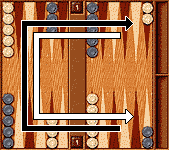Backgammon
Setup
Backgammon is a game for two players. It's played on a board consisting of 24 triangles of alternating color, called points. The board is divided into four quadrants of six points each, home board and outer board for each player. The home and outer boards are separated from each other by a center partition called the bar. Each player has fifteen stones of his own color, generally referred to as men.
The initial position of men and play direction are shown below:

Both players have their own pair of dice. A doubling cube, with the numbers 2, 4, 8, 16, 32, and 64 on its faces, is also used to keep track of the current stake of the game.
Object of the game
The object of the game is for a player to move all of his men into his own home board and then bear them off. The first player to bear off all of his men wins the game.
Movements
A player rolls two dice and two numbers on the dice constitute separate moves. He may apply both numbers for one man, or for two different men. There are three types of legal moves:
- moving a man forward the number of pips indicated on the die;
- entering a man from the bar to a point of the opposing home board corresponding to the number on the die;
- bearing off a man if all of the player's men are in his home board.
A player may not move his man to a point occupied by two or more opposing men (blocked point).
A player who rolls doubles plays the numbers shown on the dice twice. Thus, having rolled 5-5, he plays four 5's using any combination of men, which satisfies other rules.
A player must play both numbers of the roll if possible. He may not move a man in such a way that the other number(s) of the dice cannot be played if some other moves are possible. When only one number can be played, he must use the higher.
Blots
A single man on a point is called blot. A blot may be hit and sent to the bar. It must be re-entered before the player can make any other move. If the player can't enter it to an open (unblocked) point, he looses his turn. If a player can enter only some but not all of men on the bar, he enters as many as he can and looses the rest of his roll.
Bearing Off
When a player has brought all of his 15 men into his home board, he can commence bearing off. In bearing off, a player removes men from the points corresponding to the roll. If the number on the die is higher than the highest point on which the player has a man, he may bear off man from his highest occupied point. Men borne off are not re-entered into play. A player, however, may not bear off men while he has a man on the bar, or outside his home board. Thus if, a man was hit during the process of bearing off, the player must first re-enter it and bring it around into his home board before he can continue the bearing off process.
Doubling
Before the player rolls the dice to start his turn, he can offer to double the current stakes by turning the doubling cube to 2 if it's the first double in the game, or to the next value of the sequence 2, 4, 8,16 etc. if it's a redouble. The opponent may refuse the double in which case he forfeits the game at the current stake or he may accept the double. The player who accepts the double becomes the owner of the cube and only he can make the next double. Matches are normally played using the Crawford rule, which forbids doubling in some cases (see Match Rules).
Scoring
At the end of the game, if the losing player has borne off at least one checker, he loses the single value of the game as shown on the doubling cube (one point, if thef the loser has not borne off any men then the winner won gammon and receives twice the value of the doubling cube. If the loser has not borne off any men and still has one or more men on the bar or in the winner's home board then the winner won backgammon and receives three times the value of the doubling cube.
Optional rules
The following rules are used as optional:
- The Jacoby Rule. Gammons and backgammons are not scored as such if neither player doubled during the course of the game. By default this rule is disabled in all game variations except Hypergammon.
- Beavers. When a player doubles, his opponent may immediately redouble (beaver) while retaining possession of the doubling cube. By default this rule is not used.
- Automatic doubles. If both players roll the same number on the first roll of a game, game stake is doubled. By default this rule is disabled.
Match rules
Matches are played using Crawford rule. It states that if one player is one point from winning the match, doubling is disallowed in the next game. This one game without doubling is called the Crawford game. Once the Crawford game has been played, if the match has not yet been decided, the doubling is allowed in all remaining games of the match.